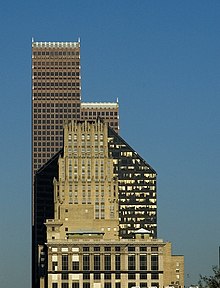
The architecture of Houston includes a wide variety of award-winning and historic examples located in various areas of the city of Houston, Texas. From early in its history to current times, the city inspired innovative and challenging building design and construction, as it quickly grew into an internationally recognized commercial and industrial hub of Texas and the United States.
Some of Houston's oldest and most distinctive architecture is found downtown, as the city grew around Allen's Landing and the Market Square historic district. During the middle and late century, Downtown Houston was a modest collection of mid-rise office structures, but has since grown into the third largest skyline in the United States. The Uptown District experienced rapid growth along with Houston during the 1970s and early 1980s. In the late 1990s Uptown Houston saw construction of many mid and high-rise residential buildings. The Uptown District is also home to other structures designed by architects such as I. M. Pei, César Pelli and Philip Johnson.
Houston has many examples of residential architecture of varying styles, from the mansions of River Oaks and Memorial to row houses in the several wards. A number of Houston's earliest homes are located in what is now Sam Houston Park. Homes in the Heights have varied architectural styles, including Victorian, Craftsman and Colonial Revival. Post-war housing constructed throughout Houston reflects many architectural styles.